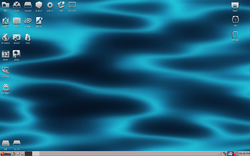
This is a list of Linux distributions that can be run entirely from a computer's RAM, meaning that once the OS has been loaded to the RAM, the media it was loaded from can be completely removed, and the distribution will run the PC through the RAM only. This ability allows them to be very fast, since reading and writing data from/to RAM is much faster than on a hard disk drive or solid-state drive. Many of these operating systems will load from a removable media such as a Live CD or a Live USB stick. A "frugal" install can also often be completed, allowing loading from a hard disk drive instead.
This feature is implemented in live-initramfs and allows the user to run a live distro that does not run from ram by default by adding toram to the kernel boot parameters.[1]
Additionally some distributions can be configured to run from RAM, such as Ubuntu using the toram option included in the Casper scripts.[2]